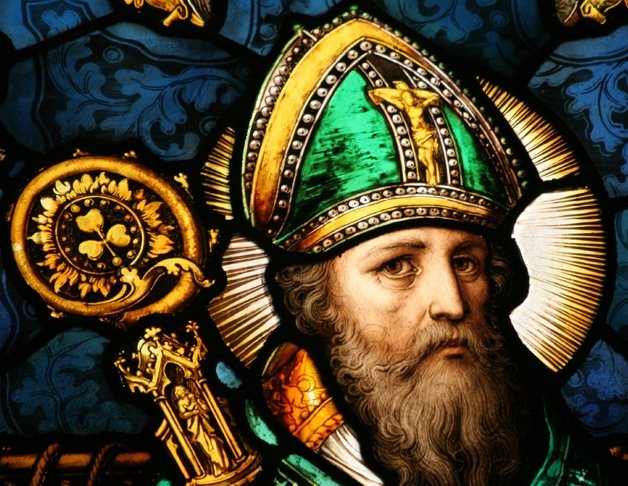‘Ah sure he’s one of our own’. These words are the words of inner city Dublin people. They may be used to describe a Garda, a Priest, the Community Nurse or a local Bank Manager. They are usually heard within earshot of the person they are directed at. It is an individual’s, or a community’s way of saying they accept you. I remember during my first week in an inner city parish, I shared a few moments in conversation with some local women. Just as I left them, and thinking I had impressed them with my competence, I overheard one of them say, ‘Ah God love him, he’s only a chiseller [1]’. Maybe I was meant to hear these words!
When I look at statues or portraits of Saint Patrick, I often think he has truly been made ‘one of our own’. Green clothing, clutching a shamrock with maps of Ireland etched in the background; he truly is one of us. Our hearts swell with pride when we walk the cities of the world and find cathedrals named in his honour: ‘one of our own’, and look at his impact.
Saint Patrick is so emblazoned with symbols of his Irishness that we forget he is an immigrant to Ireland. Not unlike the Holy Family and many families today, he was an undocumented migrant, a refugee, a slave, a member of a diaspora and a returnee. Yet somehow he transcended all of these categories and made himself ‘one of us’. I often wonder how Saint Patrick would describe himself. Did he see himself as a constant migrant, did he come back to Ireland because he felt an affinity with the people? Was he just aware of the fluidity of the world of his time, prompted by trade and transport not unlike globalisation today? Did he feel constrained in his own place among his family and community? Was he just plain restless? Did his early experience of slavery make him restless for other things? Was he someone who rose above tribal identity and found his identity in his work and his belief?
All these questions lead us to understand how Saint Patrick is relevant to us today. For many years, religious faith in Ireland gave us a sense of belonging. Many identified themselves according to the school they went to, the parish they attended or their college. Today identity is changing because our world is changing. Saint Patrick is a good model for us in this age of globalisation. As someone who we believe lived in a number of places often against his will, his identity lay beyond what geographical borders dictate.
In the past, religious faith, apart from giving us a sense of belonging, also tried to make a contribution to the advancement of society. In different ages, religious faith in both Protestant and Catholic circles promoted a sober society where people could make a valuable contribution to the workplace. Indeed, people were unknowingly at times integrated into the social fabric and cultural norms of the day with the support of their religious traditions and beliefs. Get to work on time, be sober, get promoted etc. etc. Now with many of these institutions appearing soulless and falling apart, what is the role of faith for those of us who wish to hold onto our belief in a compassionate and caring deity?
Many commentators today say that religious belief is separating from the structures that once supported and gave expression to beliefs. On a recent tour of Chicago, the guide explained that statues that once adorned cathedrals now adorn banks and other such institutions. The things that we worship and that purport to represent the highest ideals of a society have shifted, and this has affected the way we believe. In the light of this, we can ask what has St Patrick to say to our current cultural context?
Saint Patrick was not afraid of the structures of his day. From what we hear, he used the structures of Chieftain and clan to evangelise, while still remaining independent of them. As many writers say today, religious belief has less to do with propping up the pillars of society and more to do with preserving personal identity in an increasingly mediocre and secular world. The issues of ethos, presently under discussion in education, show that people of faith can depend less on institutions to support a faith identity. This is where Saint Patrick is very relevant to us. Long before he was ‘one of our own’, he was a stranger in a strange land – indeed a stranger in many strange lands – and he had to depend on God for his identity. ‘I live as an alien among non-Roman peoples, an exile on account of the love of God.’ There was no institution in Ireland to support his belief or understanding. The great insight into his identity comes from his prayer. From the moment he arose in the morning, he dedicated himself to the Trinity, and from that place of energy and belief he prayed that Christ would be his identity throughout the day – above, below and within. There were no churches, no Angelus Bells, all that reminded him of his dignity as a child of God lay within. Maybe he discovered this when he was ‘only a chiseller’ on Slemish!
Father Alan Hilliard
[1] Chiseller is Dublin slang for ‘a child’.
[2] St. Patrick’s Letter to Coroticus
Father Alan Hilliard is a priest of the Archdiocese of Dublin. This article appears courtesy of Father Donal Neary SJ, Editor of the Messenger.


